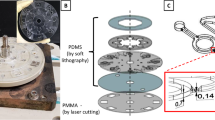Abstract
Although the reaction time for antigen-antibody binding has been greatly reduced in microchannels, other processes in heterogeneous immunoassays (HEIs), such as blocking and antigen adsorption have not benefited from miniaturization as a reduction in size to micro dimensions does not increase the speed of these processes significantly. The overall assay time of reported microfluidic HEIs has continued to be limited by these processes. In this study, we successfully develop an ultrafast quantitative HEI with pre-functionalized microfluidic poly(dimethylsiloxane) (PDMS) chips. The protein A functionalized PDMS surface is found to be highly effective in reducing the antigen adsorption time in microchannels. The functionalized surfaces can be stable at least for 2.5 months when stored at 4°C in a buffer solution consisting of 10 mM Tris, 0.05% bovine serum albumin, 0.05% Proclin 300, and 5% glycerol. In addition, the immunosorption process, which is substantially accelerated in micro scale, results in a significant reduction in nonspecific binding. The time of blocking step can therefore be reduced to a minimum or can be eliminated. The overall assay for detecting bovine immunoglobulin G is completed in 19 min with a limit of detection of 3.8 nM. The ultrafast analysis time and superior sensitivity demonstrated by this microfluidic HEI is promising for being used to develop the next-generation immunosensors.




Similar content being viewed by others
References
Bange A, Halsall HB, Heineman WR (2005) Microfluidic immunosensor systems. Biosens Bioelectron 20:2488–2503
Delehanty JB, Ligler FS (2002) A microarray immunoassay for simultaneous detection of proteins and bacteria. Anal Chem 74:5681–5687
Devi KRU, Ramalingam B, Brennan PJ, Narayanan PR, Raja A (2001) Specific and early detection of IgG, IgA and IgM antibodies to Mycobacterium tuberculosis 38 kDa antigen in pulmonary tuberculosis. Tuberculosis 81:249–253
Dittrich PS, Manz A (2006) Lab-on-a-chip: microfluidics in drug discovery. Nat Rev Drug Discov 5:210–218
Dodge A, Fluri K, Verpoote E, Rooij NF (2001) Electrokinetically driven microfluidic chips with surface-modified chambers for heterogeneous immunoassays. Anal Chem 73:3400–3409
Duffy DC, McDonald JC, Schueller OJA, Whitesides GM (1998) Rapid prototyping of microfluidic systems in poly(dimethylsiloxane). Anal Chem 70:4974–4984
Eteshola E, Leckband D (2001) Development and characterization of an ELISA assay in PDMS microfluidic channels. Sens Actuators B 72:129–133
Fintschenko Y, Wilson GS (1998) Flow injection immunoassay: a review. Mikrochim Acta 129:7–18
Growther JR (2001) The ELISA guidebook. Humana Press, Totowa
Hage DS, Thomas DH, Beck MS (1993) Theory of a sequential addition competitive binding immunoassay based on high-performance immunoaffinity chromatography. Anal Chem 65:1622–1630
Hashida S, Hashinaka K, Nishikata I, Oka S, Shimada K, Saito A, Takamizawa A, Shinagawa H, Ishikawa E (1996) Shortening of the window period in diagnosis of HIV-1 infection by simultaneous detection of p24 antigen and antibody IgG to p17 and reverse transcriptase in serum with ultrasensitive enzyme immunoassay. J Virol Meth 62:43–53
Herr AE, Hatch AV, Throckmorton DJ, Tran HM, Brennan JS, Giannobile WV, Singh AK (2007) Microfluidic immunoassays as rapid saliva-based clinical diagnostics. PNAS 104:5268–5273
Hu G, Gao Y, Sherman PM, Li D (2005) A microfluidic chip for heterogeneous immunoassay using electrokinetic control. Microfluid Nanofluid 1:346–355
Lai S, Wang S, Luo J, Lee LJ, Yang S, Madou MJ (2004) Design of a compact disk-like microfluidic platform for enzyme-linked immunosorbent assay. Anal Chem 76:1832–1837
Linder V, Verpoorte E, Rooij NF, Sigrist H, Thormann W (2002) Application of surface biopassivated disposable poly(dimethylsiloxane)/glass chips to a heterogeneous competitive human serum immunoglobulin G immunoassay with incorporated internal standard. Electrophoresis 23:740–749
Lion N, Reymond F, Girault HH, Rossier JS (2004) Why the move to microfluidics for protein analysis? Curr Opin Biotechnol 15:31–37
Makamba H, Kim JH, Lim K, Park N, Hahn JH (2003) Surface modification of poly(dimethylsiloxane) microchannels. Electrophoresis 24:3607–3619
Marquette CA, Blum LJ (2006) State of the art and recent advances in immunoanalytical systems. Biosens Bioelectron 21:1424–1433
Meagher RJ, Hatch AV, Renzi RF, Singh AK (2008) An integrated microfluidic platform for sensitive and rapid detection of biological toxins. Lab Chip 8:2046–2053
Myers FB, Lee LP (2008) Innovations in optical microfluidic technologies for point-of-care diagnostics. Lab Chip 8:2015–2031
Rossier JS, Gokulrangan G, Girault HH, Svojanovsky S, Wilson GS (2000) Characterization of protein adsorption and immunosorption kinetics in photoablated polymer microchannels. Langmuir 16:8489–8494
Salim M, O’Sullivan B, McArthur SL, Wright PC (2007) Characterization of fibrinogen adsorption onto glass microcapillary surfaces by ELISA. Lab Chip 7:64–70
Weibel DB, Siegel AC, Lee A, George AH, Whitesides GM (2007) Pumping fluids in microfluidic systems using the elastic deformation of poly(dimethylsiloxane). Lab Chip 7:1832–1836
Acknowledgments
This work was supported by the National Science Foundation (NSF-OISE-0530203) and the NSF EPSCoR Fellowship (to P. Li). We gratefully thank Prof. Stephanus Büttgenbach at the Institute for Microtechnology of Technical University of Braunschweig for helpful research collaborations, Paul W. Johnson at the RI Genomics and Sequencing Center for his excellent technical assistance with the fluorescence imaging, and Kurt Broderick at the Microsystems Technology Laboratories of Massachusetts Institute of Technology for his valuable technical assistance with the microfluidic chip fabrication.
Author information
Authors and Affiliations
Corresponding author
Rights and permissions
About this article
Cite this article
Li, P., Abolmaaty, A., D’Amore, C. et al. Development of an ultrafast quantitative heterogeneous immunoassay on pre-functionalized poly(dimethylsiloxane) microfluidic chips for the next-generation immunosensors. Microfluid Nanofluid 7, 593 (2009). https://doi.org/10.1007/s10404-009-0422-9
Received:
Accepted:
Published:
DOI: https://doi.org/10.1007/s10404-009-0422-9




